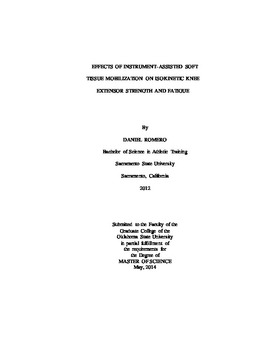| dc.contributor.advisor | O'Brien, Matthew | |
| dc.contributor.author | Romero, Daniel | |
| dc.date.accessioned | 2015-06-17T20:07:45Z | |
| dc.date.available | 2015-06-17T20:07:45Z | |
| dc.date.issued | 2014-05-01 | |
| dc.identifier.uri | https://hdl.handle.net/11244/15094 | |
| dc.description.abstract | Strength is one characteristic that most athletes focus on improving as it is a critical element for success. It is believed that some micro-tearing of the muscle tissue occurs daily in routine activities and during regular exercise. Any restriction or imbalance within the musculoskeletal structure can affect optimal range of motion which then can affect the quality of force production, force application, and movement efficacy. Nontraditional treatments are beginning to be investigated to examine their effects on strength and a few techniques are slowly gaining popularity are the Graston Technique (GT) and Whole Body Vibration (WBV). Clinicians might apply the GT before practice or competition to break down adhesions to allow the muscle to function freely or use WBV to stimulate the neuromuscular system. However, the use of the GT or WBV may possibly leave the athlete susceptible to injury if strength is diminished in the process. PURPOSE: The purpose of this study is to address the potential acute effects of the GT and WBV on peak isokinetic torque and fatigue of the quadriceps during maximal voluntary contraction. The secondary purpose is to compare the individual effects between the GT and WBV on strength and fatigue following an acute exercise protocol. METHODS: Subjects were randomly selected into three groups: the GT, WBV and control. Each subject completed their group protocol a week after the pre-test. Peak isokinetic torque, total work and work fatigue values were collected pre-test and post-test using the Thorstennson protocol on the Biodex dynamometer 4.0. Following data collection, independent sample t-tests and a one-way ANOVA were performed on SPSS Statistics to analyze the data. RESULTS: Peak isokinetic torque and work fatigue decreased following each intervention. There was no significant difference between pre-test and post-test or between groups. Total work only increased in the GT but not significantly when compared to the WBV and control group. CONCLUSION: Based on the results, it is safe to assume that the GT and WBV is not better or worse than resting for 5 minutes before practice or competition when it comes to strength and fatigue. | |
| dc.format | application/pdf | |
| dc.language | en_US | |
| dc.publisher | Oklahoma State University | |
| dc.rights | Copyright is held by the author who has granted the Oklahoma State University Library the non-exclusive right to share this material in its institutional repository. Contact Digital Library Services at lib-dls@okstate.edu or 405-744-9161 for the permission policy on the use, reproduction or distribution of this material. | |
| dc.title | Effects of Instrument-assisted Soft Tissue Mobilization on Isokinetic Knee Extensor Strength and Fatigue | |
| dc.type | text | |
| dc.contributor.committeeMember | Smith, Doug | |
| dc.contributor.committeeMember | Warren, Aric | |
| osu.filename | Romero_okstate_0664M_13372.pdf | |
| osu.accesstype | Open Access | |
| dc.description.department | Health Care Administration | |
| dc.type.genre | Thesis | |
| dc.subject.keywords | fatigue | |
| dc.subject.keywords | graston technique | |
| dc.subject.keywords | strength | |
| dc.subject.keywords | whole body vibration | |
